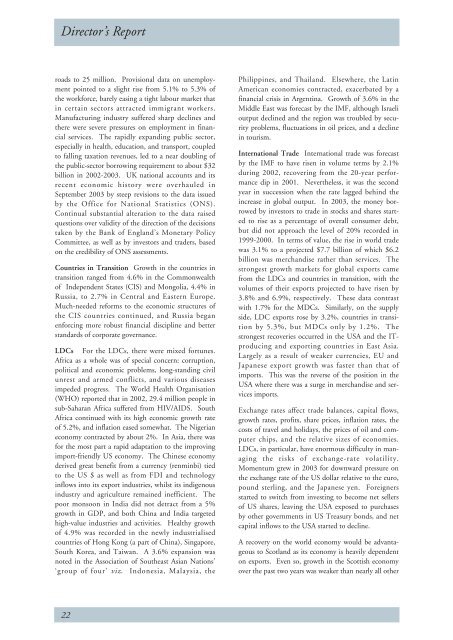PDF file: Annual Report 2002/2003 - Scottish Crop Research Institute
PDF file: Annual Report 2002/2003 - Scottish Crop Research Institute
PDF file: Annual Report 2002/2003 - Scottish Crop Research Institute
Create successful ePaper yourself
Turn your PDF publications into a flip-book with our unique Google optimized e-Paper software.
Director’s <strong>Report</strong><br />
roads to 25 million. Provisional data on unemployment<br />
pointed to a slight rise from 5.1% to 5.3% of<br />
the workforce, barely easing a tight labour market that<br />
in certain sectors attracted immigrant workers.<br />
Manufacturing industry suffered sharp declines and<br />
there were severe pressures on employment in financial<br />
services. The rapidly expanding public sector,<br />
especially in health, education, and transport, coupled<br />
to falling taxation revenues, led to a near doubling of<br />
the public-sector borrowing requirement to about $32<br />
billion in <strong>2002</strong>-<strong>2003</strong>. UK national accounts and its<br />
recent economic history were overhauled in<br />
September <strong>2003</strong> by steep revisions to the data issued<br />
by the Office for National Statistics (ONS).<br />
Continual substantial alteration to the data raised<br />
questions over validity of the direction of the decisions<br />
taken by the Bank of England’s Monetary Policy<br />
Committee, as well as by investors and traders, based<br />
on the credibility of ONS assessments.<br />
Countries in Transition Growth in the countries in<br />
transition ranged from 4.6% in the Commonwealth<br />
of Independent States (CIS) and Mongolia, 4.4% in<br />
Russia, to 2.7% in Central and Eastern Europe.<br />
Much-needed reforms to the economic structures of<br />
the CIS countries continued, and Russia began<br />
enforcing more robust financial discipline and better<br />
standards of corporate governance.<br />
LDCs For the LDCs, there were mixed fortunes.<br />
Africa as a whole was of special concern: corruption,<br />
political and economic problems, long-standing civil<br />
unrest and armed conflicts, and various diseases<br />
impeded progress. The World Health Organisation<br />
(WHO) reported that in <strong>2002</strong>, 29.4 million people in<br />
sub-Saharan Africa suffered from HIV/AIDS. South<br />
Africa continued with its high economic growth rate<br />
of 5.2%, and inflation eased somewhat. The Nigerian<br />
economy contracted by about 2%. In Asia, there was<br />
for the most part a rapid adaptation to the improving<br />
import-friendly US economy. The Chinese economy<br />
derived great benefit from a currency (renminbi) tied<br />
to the US $ as well as from FDI and technology<br />
inflows into its export industries, whilst its indigenous<br />
industry and agriculture remained inefficient. The<br />
poor monsoon in India did not detract from a 5%<br />
growth in GDP, and both China and India targeted<br />
high-value industries and activities. Healthy growth<br />
of 4.9% was recorded in the newly industrialised<br />
countries of Hong Kong (a part of China), Singapore,<br />
South Korea, and Taiwan. A 3.6% expansion was<br />
noted in the Association of Southeast Asian Nations’<br />
‘group of four’ viz. Indonesia, Malaysia, the<br />
Philippines, and Thailand. Elsewhere, the Latin<br />
American economies contracted, exacerbated by a<br />
financial crisis in Argentina. Growth of 3.6% in the<br />
Middle East was forecast by the IMF, although Israeli<br />
output declined and the region was troubled by security<br />
problems, fluctuations in oil prices, and a decline<br />
in tourism.<br />
International Trade International trade was forecast<br />
by the IMF to have risen in volume terms by 2.1%<br />
during <strong>2002</strong>, recovering from the 20-year performance<br />
dip in 2001. Nevertheless, it was the second<br />
year in succession when the rate lagged behind the<br />
increase in global output. In <strong>2003</strong>, the money borrowed<br />
by investors to trade in stocks and shares started<br />
to rise as a percentage of overall consumer debt,<br />
but did not approach the level of 20% recorded in<br />
1999-2000. In terms of value, the rise in world trade<br />
was 3.1% to a projected $7.7 billion of which $6.2<br />
billion was merchandise rather than services. The<br />
strongest growth markets for global exports came<br />
from the LDCs and countries in transition, with the<br />
volumes of their exports projected to have risen by<br />
3.8% and 6.9%, respectively. These data contrast<br />
with 1.7% for the MDCs. Similarly, on the supply<br />
side, LDC exports rose by 3.2%, countries in transition<br />
by 5.3%, but MDCs only by 1.2%. The<br />
strongest recoveries occurred in the USA and the ITproducing<br />
and exporting countries in East Asia.<br />
Largely as a result of weaker currencies, EU and<br />
Japanese export growth was faster than that of<br />
imports. This was the reverse of the position in the<br />
USA where there was a surge in merchandise and services<br />
imports.<br />
Exchange rates affect trade balances, capital flows,<br />
growth rates, profits, share prices, inflation rates, the<br />
costs of travel and holidays, the prices of oil and computer<br />
chips, and the relative sizes of economies.<br />
LDCs, in particular, have enormous difficulty in managing<br />
the risks of exchange-rate volatility.<br />
Momentum grew in <strong>2003</strong> for downward pressure on<br />
the exchange rate of the US dollar relative to the euro,<br />
pound sterling, and the Japanese yen. Foreigners<br />
started to switch from investing to become net sellers<br />
of US shares, leaving the USA exposed to purchases<br />
by other governments in US Treasury bonds, and net<br />
capital inflows to the USA started to decline.<br />
A recovery on the world economy would be advantageous<br />
to Scotland as its economy is heavily dependent<br />
on exports. Even so, growth in the <strong>Scottish</strong> economy<br />
over the past two years was weaker than nearly all other<br />
22
















